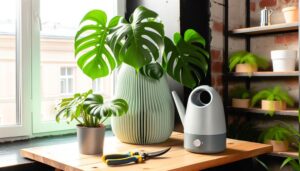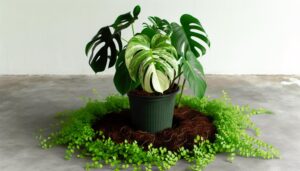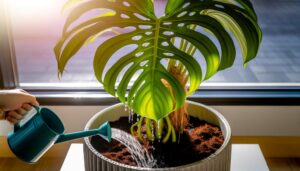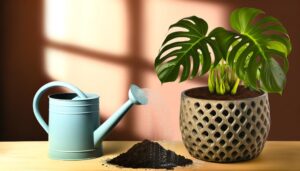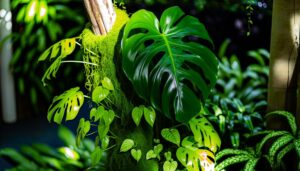Monstera Pinnatipartita Vs Subpinnata
Monstera Pinnatipartita and Monstera Subpinnata both originate from Central and South American rainforests. Monstera Pinnatipartita has deeply fenestrated leaves up to 60 cm, while Subpinnata's leaves are segmented and reach 40 cm.
Pinnatipartita grows faster and requires frequent pruning; both thrive in humid, indirect light. Use well-draining soil rich in organic matter and maintain humidity at 60-80%.
Pinnatipartita prefers temperatures between 65°F-80°F, while Subpinnata tolerates cooler conditions better. If you're interested in more detailed care tips, pest management strategies, and propagation methods, there's much more to explore.
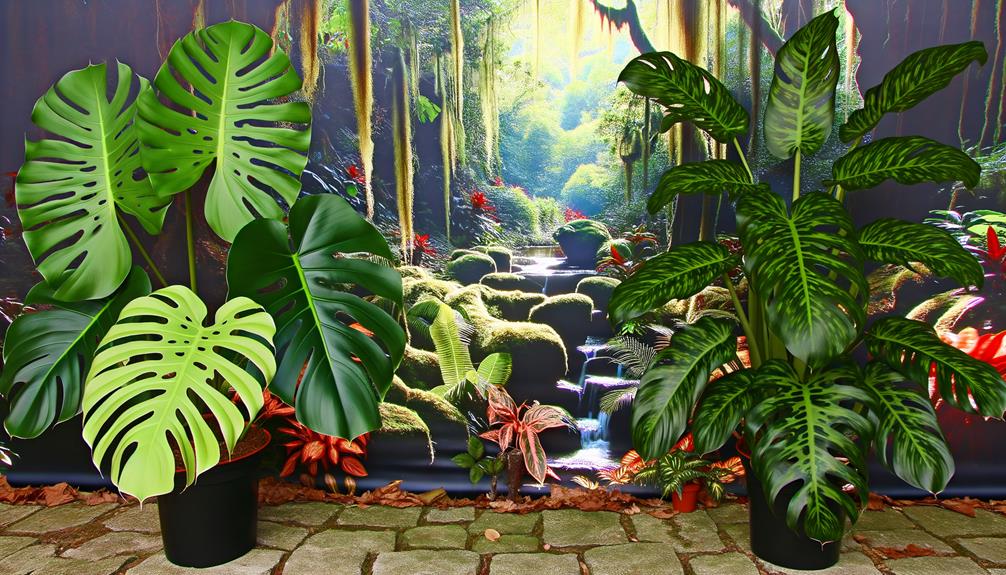
Key Takeaways
- Monstera Pinnatipartita has deeply fenestrated leaves, while Monstera Subpinnata features segmented leaves with elongated lobes.
- Pinnatipartita grows more rapidly than Subpinnata under ideal conditions, requiring more frequent pruning.
- Both species thrive in high humidity and bright, indirect light environments typical of tropical rainforests.
- Pinnatipartita prefers temperatures between 65°F to 80°F, whereas Subpinnata can tolerate slightly cooler conditions.
- Common pests include spider mites, scale insects, and mealybugs, manageable with neem oil and integrated pest management techniques.
Origin and Natural Habitat
When comparing Monstera pinnatipartita and Monstera subpinnata, you'll find that both species originate from the tropical rainforests of Central and South America, thriving in the humid and shaded understory. These environments provide the ideal microclimates necessary for their growth.
Monstera pinnatipartita typically inhabits the lower forest strata where indirect sunlight prevails, maintaining a consistent moisture level. Similarly, Monstera subpinnata prefers these conditions, leveraging the high humidity and diffused light for best photosynthesis.
Both species exhibit epiphytic tendencies, often climbing trees to access better light and air circulation. By anchoring their roots into bark crevices, they secure essential nutrients and stability. Their natural habitats are essential for understanding their care and requirements in cultivation.
Leaf Shape and Size
Understanding their natural habitats provides valuable context for analyzing the distinct leaf shapes and sizes of Monstera pinnatipartita and Monstera subpinnata.
Monstera pinnatipartita exhibits larger, deeply fenestrated leaves with pronounced lobes, maximizing photosynthetic efficiency in low-light rainforest understories. These leaves can reach up to 60 centimeters in length.
By contrast, Monstera subpinnata features narrower, more segmented leaves with elongated lobes, resembling a feather. These leaves typically grow up to 40 centimeters long.
The pinnate structure of Monstera subpinnata enhances light capture in its native environment, optimizing growth.
Both species' leaf morphology reflects adaptive strategies to their ecological niches, with varying fenestration and segmentation patterns tailored to distinct light conditions and microhabitats.
Growth Rate
When evaluating growth rates, you'll notice Monstera Pinnatipartita grows more rapidly compared to Subpinnata under ideal conditions. Both species thrive in high humidity and indirect light, but Pinnatipartita's faster growth necessitates more frequent pruning to maintain its shape.
Understanding each plant's ideal environment and maintenance needs is vital for promoting healthy development.
Comparing Growth Speeds
Growth rates for Monstera pinnatipartita and Monstera subpinnata differ markedly due to variations in their physiological and environmental requirements. Monstera pinnatipartita typically exhibits a faster growth rate owing to its robust root system and higher photosynthetic efficiency. This species can produce new leaves rapidly, especially when provided with ideal light and humidity levels.
Conversely, Monstera subpinnata grows at a more moderate pace. Its growth is characterized by the gradual elongation of stems and the slower unfurling of its uniquely pinnate leaves. Differences in nutrient uptake mechanisms and cellular respiration rates further contribute to these disparities.
Understanding these growth speed variations will help you manage their development more effectively, ensuring that each plant thrives under your care.
Ideal Growing Conditions
To enhance the growth rates of Monstera pinnatipartita and Monstera subpinnata, you'll need to tailor their growing conditions to meet each species' specific light, humidity, and nutrient requirements. Both species thrive in bright, indirect light. Direct sunlight can cause leaf burn, so make sure they receive filtered light.
Maintain humidity levels between 60-80%, as these tropical plants are humidity-sensitive. Utilize a balanced fertilizer with a 20-20-20 ratio during the growing season to provide essential nutrients. Soil should be well-draining, rich in organic matter, and consistently moist but not waterlogged.
Regularly monitor environmental conditions and adjust as necessary to promote optimal growth and minimize stress factors. This careful attention ensures robust growth and vibrant foliage.
Pruning and Maintenance
Proper pruning and regular maintenance are crucial for managing the growth rate and overall health of Monstera pinnatipartita and Monstera subpinnata.
Use sterilized pruning shears to remove dead or damaged leaves, which helps prevent disease and pest infestations.
For Monstera pinnatipartita, trim back overgrown stems to promote fuller foliage.
Monstera subpinnata requires more frequent pruning due to its faster growth rate; target the removal of leggy or unruly vines to encourage a bushier appearance.
Both species benefit from periodic checks for aerial roots, which you can trim or redirect to the soil.
Regularly wipe leaves with a damp cloth to remove dust, enhancing photosynthesis.
Consistent maintenance guarantees vigorous growth and vibrant, healthy plants.
Light Requirements
Both Monstera pinnatipartita and Monstera subpinnata thrive in bright, indirect light, which mimics their natural understory habitat. You should place them near a window filtered by sheer curtains, ensuring they receive ample light without direct sun exposure.
Direct sunlight can scorch their leaves, causing damage and stunted growth. If natural light is insufficient, consider using grow lights with a spectrum that simulates daylight. Aim for about 12-14 hours of light daily, particularly in winter.
Monitor the plants for signs of inadequate light, such as leggy growth or pale leaves. By providing ideal lighting conditions, you can promote vigorous growth and maintain the lush, vibrant foliage characteristic of these Monstera species.
Watering Needs
When addressing the watering needs of Monstera Pinnatipartita and Subpinnata, you'll find their best moisture levels vary slightly. Monstera Pinnatipartita thrives with consistently moist soil, while Subpinnata prefers the soil to dry out slightly between waterings.
Assess the frequency of watering by monitoring the top inch of soil; it should remain moist for Pinnatipartita but can be allowed to dry out for Subpinnata.
Optimal Moisture Levels
Understanding the best moisture levels for Monstera Pinnatipartita and Subpinnata is necessary for ensuring their healthy growth and preventing root rot. Both species thrive in moderately moist soil, but it's important to avoid waterlogged conditions. Aim for a balance where the soil stays slightly damp but not soggy.
| Species | Ideal Moisture Level | Soil Type |
|---|---|---|
| Monstera Pinnatipartita | Slightly damp, not wet | Well-draining, organic |
| Monstera Subpinnata | Even moisture, not waterlogged | Loamy, well-aerated |
Monitor the soil's moisture by inserting your finger an inch deep; it should feel moist but not saturated. Using a moisture meter can provide a more accurate reading. Ensuring proper drainage with appropriate soil mix and containers is important for optimal moisture management.
Frequency of Watering
Determining the frequency of watering for Monstera Pinnatipartita and Subpinnata hinges on several key factors, including the plant's growth stage, environmental conditions, and soil type.
For mature plants, make sure the top inch of soil is dry before watering again. Younger plants might need more frequent watering due to their higher metabolic rates.
Environmental conditions such as temperature and humidity also play a critical role; higher temperatures and lower humidity levels will require more frequent watering.
Soil type affects water retention: a well-draining mix reduces the risk of root rot. You should aim for consistently moist but not waterlogged soil.
Monitoring these variables will help you fine-tune your watering schedule for optimal plant health.
Soil Preferences
Both Monstera pinnatipartita and Monstera subpinnata thrive in well-draining, aerated soil rich in organic matter. You should aim for a mix that includes peat moss, perlite, and orchid bark to guarantee excellent drainage and aeration. Peat moss retains moisture while providing essential nutrients, while perlite enhances soil aeration, preventing root rot. Orchid bark contributes to the soil structure, fostering robust root development.
Moreover, incorporating compost can greatly enhance the organic content, promoting healthy microbial activity. Avoid compacted or clay-heavy soils, as they hinder drainage and airflow, risking root suffocation. A pH level of 5.5 to 7.0 is ideal, as it ensures nutrient availability.
Regularly check soil moisture to maintain a balance, providing an environment conducive to growth.
Humidity Levels
Maintaining high moisture levels, ideally between 60-80%, is important for the best growth of Monstera pinnatipartita and Monstera subpinnata. These tropical plants thrive in damp environments, mimicking their native rainforest habitats.
You can achieve peak moisture by using a humidifier, placing a tray of water near the plant, or grouping plants together to create a microenvironment. Consistent moisture prevents leaf browning and promotes vigorous growth. Monitor the moisture with a hygrometer to optimize it remains within the desired range.
If the air is too dry, the plants may exhibit signs of stress, such as curling leaves and stunted growth. Proper moisture management is essential for maintaining the health and aesthetic appeal of your Monsteras.
Temperature Tolerance
You'll find that Monstera Pinnatipartita and Subpinnata have distinct temperature preferences.
Monstera Pinnatipartita thrives best in temperatures between 65°F and 80°F, while Subpinnata can tolerate slightly cooler conditions.
However, both species exhibit limited cold tolerance and may suffer stress or damage when exposed to temperatures below 50°F.
Ideal Temperature Range
When cultivating Monstera Pinnatipartita and Subpinnata, it's important to maintain an ideal temperature range between 65°F and 80°F to achieve the best growth. These tropical plants thrive in consistent, warm temperatures, avoiding extremes that could stress them. Monitoring temperature precisely ensures robust leaf development and overall plant health.
Here's a comparative table for quick reference:
| Parameter | Best Range (°F) |
|---|---|
| Monstera Pinnatipartita | 65°F – 80°F |
| Monstera Subpinnata | 65°F – 80°F |
| Optimal Day Temperature | 70°F – 75°F |
| Ideal Night Temperature | 65°F – 70°F |
| Extreme Temperature Risk | Below 60°F or Above 85°F |
Maintaining this range helps in achieving photosynthetic efficiency and metabolic stability, vital for growth and health.
Cold Tolerance Limits
Cold tolerance limits for Monstera Pinnatipartita and Subpinnata are necessary to understand, as exposure to temperatures below 60°F can severely stress or damage these tropical plants.
Monstera Pinnatipartita, native to South America, exhibits moderate cold resilience but suffers cellular harm at prolonged exposures below 50°F.
Conversely, Monstera Subpinnata, hailing from Central and South America, shows slightly better endurance, enduring short-term dips to 45°F.
However, both species experience reduced metabolic functions, stunted growth, and leaf chlorosis when exposed to cold stress.
Ensuring proper insulation during colder months, such as using thermal blankets or relocating indoors, can mitigate potential damage.
Monitoring ambient temperatures is essential in maintaining ideal health for these tropical beauties.
Heat Tolerance Comparison
While cold resistance is a crucial aspect of Monstera care, understanding their heat resistance is equally important for maintaining their overall health and strength.
Monstera pinnatipartita thrives in temperatures ranging from 65°F to 85°F, showing resilience to occasional spikes up to 90°F. However, prolonged exposure to temperatures above 95°F can cause leaf scorch and dehydration.
In contrast, Monstera subpinnata prefers slightly cooler conditions, performing at its best between 60°F and 80°F. It can tolerate brief periods of heat up to 85°F, but sustained high temperatures can lead to stress and hinder growth.
Both species require high humidity to mitigate heat stress, so maintain consistent humidity levels above 60% to support their physiological processes during hot conditions.
Propagation Methods
Propagating Monstera Pinnatipartita and Subpinnata involves detailed steps such as selecting healthy stem cuttings, guaranteeing ideal rooting conditions, and using appropriate growth mediums to foster successful plant development.
Begin by choosing a robust stem with at least one node and aerial root. Use sterilized pruning shears to make a clean cut below the node. Place the cutting in a glass of water or a well-draining soil mix, making sure the node is submerged. Maintain a humid environment with indirect sunlight to encourage root growth.
Change the water every few days if using the water method. Once roots are 2-3 inches long, transplant the cutting into a pot with nutrient-rich soil. This method secures vigorous propagation.
Common Pests
Monstera Pinnatipartita and Subpinnata are commonly afflicted by pests such as spider mites, scale insects, and mealybugs, which can cause significant damage if not promptly addressed.
Spider mites are tiny arachnids that puncture plant cells to feed, resulting in stippling and webbing on leaves. Scale insects, often appearing as small, immobile bumps, secrete a waxy coating for protection while sucking sap, leading to yellowing and weakened plants. Mealybugs, identifiable by their white, cotton-like masses, also extract sap and excrete honeydew, fostering mold growth.
To combat these pests, implement integrated pest management strategies like regular inspections, neem oil applications, and introducing predatory insects. Swift action mitigates damage and ensures healthier Monstera plants.
Toxicity to Pets
In addition to managing pests, it's important to be aware that both Monstera Pinnatipartita and Subpinnata contain calcium oxalate crystals, making them toxic to pets if ingested. These needle-like crystals can cause severe oral irritation, excessive drooling, and difficulty swallowing.
You may observe your pet pawing at its mouth or showing signs of gastrointestinal distress, such as vomiting. Immediate veterinary attention is essential to prevent complications. Keep these plants out of reach, and consider barriers or alternative placements.
Understanding this toxicity helps you make informed decisions, ensuring your pet's safety. Remember, even a small nibble can lead to significant discomfort and potential health risks for your furry friends.
Aesthetic Appeal
Both Monstera Pinnatipartita and Subpinnata captivate plant enthusiasts with their intricate leaf patterns and unique fenestrations, making them standout additions to any indoor greenery collection.
The Pinnatipartita features deeply divided leaves with prominent, elongated perforations that enhance its exotic look. Its vibrant green foliage matures to reveal more pronounced fenestrations, creating a dynamic visual transformation over time.
In contrast, the Subpinnata boasts finely dissected leaves with a feather-like appearance, offering a more delicate aesthetic. The leaves' segmented structure creates a lace-like texture, providing an elegant and airy feel.
Both species exhibit a sophisticated morphology that appeals to collectors seeking botanical artistry. Their distinct characteristics ensure they'll be focal points in any plant display, blending scientific intrigue with natural beauty.
Conclusion
In comparing Monstera pinnatipartita and Monstera subpinnata, you'll find each has unique traits that can fit different preferences. Monstera pinnatipartita's rapid growth and larger leaves might appeal if you're aiming for a lush, tropical vibe.
Surprisingly, studies show that Monstera plants can improve indoor air quality by removing toxins.
Whichever you choose, both species offer an engaging blend of aesthetic appeal and ecological benefits, making them fantastic additions to your plant collection.

